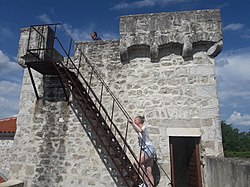Islam Grčki is a village in the municipality of Benkovac, in the Zadar County, Croatia.
Islam Grčki | |
|---|---|
 The Kula Jankovića (Janković Tower), a fort in which Stojan Janković and his descendants lived. It is now owned by the Desnica family. | |
| Coordinates: 44°10′N 15°27′E / 44.167°N 15.450°E | |
| Country | |
| County | Zadar |
| Municipality | Benkovac |
| Area | |
| • Total | 13.8 km2 (5.3 sq mi) |
| Population (2021)[2] | |
| • Total | 150 |
| • Density | 11/km2 (28/sq mi) |
| Time zone | UTC+1 (CET) |
| • Summer (DST) | UTC+2 (CEST) |
Geography
editIslam Grčki is located in the Ravni Kotari area, 23 kilometres (14 mi) away from Benkovac and 20 km (12 mi) away from Zadar. The village is also only 3 km (1.9 mi) away from the Adriatic Sea but it does not play a major role in the villages economy.
Name
editThe original name of the village was Saddislam, meaning "The wall of Islam" in Ottoman Turkish which marked the final frontier of the Ottoman Empire.
In the 18th century, when the village split in two, the name changed to Islam Grčki. While Islam stayed from the original name, the adjective Grčki (meaning "Greek") stands for the religion of the villagers - Orthodoxy. The other part of the split up village, Islam Latinski, got its name from the religious belief of its settlers - Catholicism.[citation needed]
A former Italian name was Sant'Anastasia Alta.[citation needed]
History
editThe history of Islam Grčki goes back to the Middle Ages. The village was an Uskok stronghold in the 16th and 17th century. The most notable Uskok leader Stojan Janković got possession of the village after the Cretan War. He built the villages most notable object - the Janković Kula.
During World War II the village, a Serb enclave surrounded by Croatian villages, was a firm Chetnik militia stronghold. Some villagers also joined the Italian collaborationist Anti-Communist Volunteer Militia.
After World War II the village became part of the Socialist Republic of Croatia. During the Croatian war of independence the village was one of the first areas under Krajina Serb control. The village was partly destroyed by shelling during the Croatian-led Operation Maslenica and was overtaken by the Croatian forces on 22 January 1993.[3]
A big part of the villages population fled during the war and the village itself suffered a lot material damage. Janković Kula, for instance, was destroyed in the shelling of 1993 but was being rebuilt as of 2012.[4]
Demographics
editThe village is predominantly ethnic Serb,[5][6] and as of 2011 has 150 inhabitants.[7] This represents 13.17% of its pre-war population according to the 1991 census.
The 1991 census[8] recorded that 87.00% of the village population were ethnic Serbs (991/1139), 9.39% were Croats (107/1139) while 3.61% were of other ethnic origin (41/1139).
| population | 480 | 665 | 561 | 552 | 621 | 846 | 703 | 843 | 1117 | 1152 | 1277 | 1400 | 1239 | 1139 | 108 | 150 | 150 |
| 1857 | 1869 | 1880 | 1890 | 1900 | 1910 | 1921 | 1931 | 1948 | 1953 | 1961 | 1971 | 1981 | 1991 | 2001 | 2011 | 2021 |
Sights
edit- Orthodox Church of St. George
- The Stojan Janković' Tower
See also
editSources
edit- ^ Register of spatial units of the State Geodetic Administration of the Republic of Croatia. Wikidata Q119585703.
- ^ "Population by Age and Sex, by Settlements" (xlsx). Census of Population, Households and Dwellings in 2021. Zagreb: Croatian Bureau of Statistics. 2022.
- ^ Vojna povijest, no. 22, page 14
- ^ "Kamen po kamen - Kula + FOTOGALERIJA - Hrvatska - H-Alter". Archived from the original on 2012-10-24. Retrieved 2012-11-26.
- ^ "Zadruga oživljava Islam Grčki". portalnovosti.com (in Serbian). 20 August 2011. Retrieved 12 August 2018.
- ^ "Sumrak 'male Kalifornije'". portalnovosti.com (in Serbian). 14 September 2016. Retrieved 12 August 2018.
- ^ "Population by Age and Sex, by Settlements, 2011 Census: Islam Grčki". Census of Population, Households and Dwellings 2011. Zagreb: Croatian Bureau of Statistics. December 2012.
- ^ Izdanje Državnog zavoda za statistiku RH: Narodnosni sastav stanovništva RH od 1880-1991. godine.
- ^ "Croats Battle Serbs for a Key Bridge Near the Adriatic". New York Times. January 24, 1993. Retrieved January 21, 2019.
